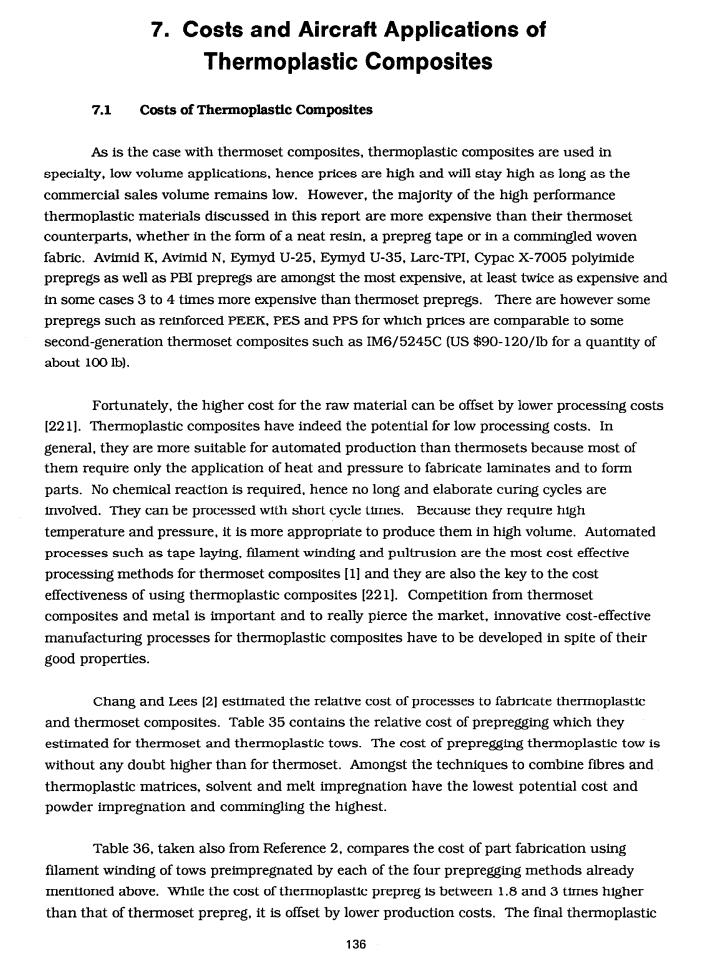正在加载图片...

7.Costs and Aircraft Applications of Thermoplastic Composites 7.1 Costs of Thermoplastlc Composites As is the case with thermoset composites,thermoplastic composites are used in specialty,low volume applications,hence prices are high and will stay high as long as the commercial sales volume remains low.However,the majority of the high performance thermoplastic materials discussed in this report are more expensive than their thermoset counterparts,whether in the form of a neat resin,a prepreg tape or in a commingled woven fabric.Avimid K,Avimid N.Eymyd U-25.Eymyd U-35.Larc-TPI,Cypac X-7005 polyimide prepregs as well as PBI prepregs are amongst the most expensive,at least twice as expensive and in some cases 3 to 4 times more expensive than thermoset prepregs.There are however some prepregs such as reinforced PEEK,PES and PPS for which prices are comparable to some second-generation thermoset composites such as IM6/5245C (US $90-120/Ib for a quantity of about 100 Ib). Fortunately,the higher cost for the raw material can be offset by lower processing costs [221].Thermoplastic composites have indeed the potential for low processing costs.In general,they are more suitable for automated production than thermosets because most of them require only the application of heat and pressure to fabricate laminates and to form parts.No chemical reaction is required.hence no long and elaborate curing cycles are involved.They can be processed with short cycle ttes.Because they require high temperature and pressure,it is more appropriate to produce them in high volume.Automated processes such as tape laying.filament winding and pultrusion are the most cost effective processing methods for thermoset composites [1]and they are also the key to the cost effectiveness of using thermoplastic composites [221].Competition from thermoset composites and metal is important and to really pierce the market,innovative cost-effective manufacturing processes for thermoplastic composites have to be developed in spite of their good properties. Chang and Lees [2]estimated the relative cost of processes to fabricate thermoplastic and thermoset composites.Table 35 contains the relative cost of prepregging which they estimated for thermoset and thermoplastic tows.The cost of prepregging thermoplastic tow is without any doubt higher than for thermoset.Amongst the techniques to combine fibres and thermoplastic matrices,solvent and melt impregnation have the lowest potential cost and powder impregnation and commingling the highest. Table 36,taken also from Reference 2.compares the cost of part fabrication using filament winding of tows preimpregnated by each of the four prepregging methods already mentioned above.While the cost of thermnoplastic prepreg is between 1.8 and 3 times higher than that of thermoset prepreg.it is offset by lower production costs.The final thermoplastic 1367. Costs and Aircraft Applications of Thermoplastic Composites 7.1 Costs of Thermoplastic Composites As is the case with thermoset composites, thermoplastic composites are used in specialty, low volume applications, hence prices are high and will stay high as long as the commercial sales volume remains low. However, the majority of the high performance thermoplastic materials discussed in this report are more expensive than their thermoset counterparts, whether in the form of a neat resin, a prepreg tape or in a commingled woven fabric. Avimid K, Avimid N, Eymyd U-25, Eymyd U-35, Larc-TPI. Cypac X-7005 polyimide prepregs as well as PBI prepregs are amongst the most expensive, at least twice as expensive and in some cases 3 to 4 times more expensive than thermoset prepregs. There are however some prepregs such as reinforced PEEK, PES and PPS for which prices are comparable to some second-generation thermoset composites such as IM6/5245C (US $90-12O/lb for a quantity of about 100 lb]. Fortunately, the higher cost for the raw material can be offset by lower processing costs 122 11. Thermoplastic composites have indeed the potential for low processing costs. In general, they are more suitable for automated production than thermosets because most of them require only the application of heat and pressure to fabricate laminates and to form parts. No chemical reaction is required, hence no long and elaborate curing cycles are involved. They can be processed with short cycle times. Because they require high temperature and pressure, it is more appropriate to produce them in high volume. Automated processes such as tape laying, filament winding and pultrusion are the most cost effective processing methods for thermoset composites [l] and they are also the key to the cost effectiveness of using thermoplastic composites 122 11. Competition from thermoset composites and metal is Important and to really pierce the market, innovative cost-effective manufacturing processes for thermoplastic composites have to be developed in spite of their good properties. Chang and Lees [Z] estimated the relative cost of processes to fabricate thermoplastic and thermoset composites. Table 35 contains the relative cost of prepregging which they estimated for thermoset and thermoplastic tows. The cost of prepregging thermoplastic tow is without any doubt higher than for thermoset. Amongst the techniques to combine fibres and thermoplastic matrices, solvent and melt impregnation have the lowest potential cost and powder impregnation and commingling the highest. Table 36, taken also from Reference 2, compares the cost of part fabrication using filament winding of tows preimpregnated by each of the four prepregging methods already mentioned above. While the cost of thermoplastic prepreg is between 1.8 and 3 times higher than that of thermoset prepreg, it is offset by lower production costs. The final thermoplastic 136